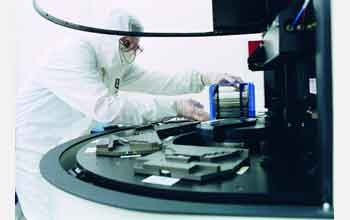Multimedia Gallery
ATE Centers (Image 7)
A technician at Texas Instruments processes wafers containing computer microchips. The Maricopa Advanced Technology Education Center effects change in technician education through the creation of competency-based curricula, diverse and effective professional development programs and replicable workforce development models. [Image 7 of 12 related images. See Image 8.] (Date of Image: 2009)
More about this Image
Funded in part by a grant from the National Science Foundation's (NSF) Advanced Technological Education (ATE) program (grant DUE 05-01626), the Maricopa Advanced Technology Education Center (MATEC) is a national center of excellence that focuses on development of technician education in semiconductor manufacturing, automation, electronics, alternative and renewable energies and related fields. MATEC produces and delivers unique, Web-based resources that help faculty prepare students to graduate with the skills they need, and that their employers want.
MATEC offers a national resource center called NetWorks, that provides the venues for creating, sharing and promoting a premier collection of digital resources and faculty professional development opportunities, such as a digital, online library of 1,100 classroom-ready technology lessons and other pedagogical resources, Web seminar series, conferences and a virtual community with forums such as a TechSpectives blog.
Working in partnership with education and industry, MATEC develops programs, materials and training that enable students, faculty and technicians to continuously master the evolving competencies in science, mathematics, technology and communications required by the workforce of the semiconductor, electronics and advanced manufacturing industries. MATEC is located at Maricopa Community College in Tempe, Ariz. For more information about MATEC, visit the center's website Here. Information about NetWorks is available Here.
NSF's ATE program supports efforts to improve the knowledge and skills of technicians who work in high-technology fields that drive the nation's economy. The program focuses on undergraduates, secondary school students and incumbent technicians, as well as on the educators who teach them. Community colleges are the main providers of education for technicians and have leadership roles in all ATE initiatives, working closely with industry, government and educators in other sectors to enhance the skills of the men and women who are essential to the vitality of the nation's economy. ATE partnerships help create new curricula; reform existing programs; enrich the technical knowledge of experienced college faculty members and teachers; prepare prospective educators with solid foundations in science, technology, engineering and mathematics; and undertake applied research in technological education. Further information on NSF's ATE program is available Here.
Credit: Photo from ATE Centers Impact 2008-2010 (www.atecenters.org)
Images and other media in the National Science Foundation Multimedia Gallery are available for use in print and electronic material by NSF employees, members of the media, university staff, teachers and the general public. All media in the gallery are intended for personal, educational and nonprofit/non-commercial use only.
Images credited to the National Science Foundation, a federal agency, are in the public domain. The images were created by employees of the United States Government as part of their official duties or prepared by contractors as "works for hire" for NSF. You may freely use NSF-credited images and, at your discretion, credit NSF with a "Courtesy: National Science Foundation" notation.
Additional information about general usage can be found in Conditions.
Also Available:
Download the high-resolution JPG version of the image. (1.6 MB)
Use your mouse to right-click (Mac users may need to Ctrl-click) the link above and choose the option that will save the file or target to your computer.



